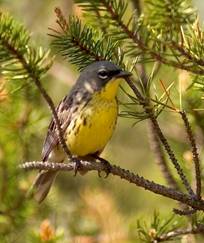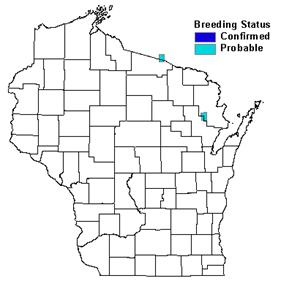

Status/Protection
- Global Rank: G1 Key to global and state ranks
- State Rank: SNAB
- WBCI Priority: SGCN, PIF, State Special Concern
Population Information
- Federal Breeding Bird Survey: NA; this species is too rare to be monitored effectively by the BBS.
- Kirtland’s Warbler Singing Male Survey: significantly increasing.
- WSO Checklist Project: NA (Not found by Wisconsin Checklist Project participants).
Monitoring by WDNR and US F&WS personnel in jack pine forests in Wisconsin has turned up singing males in a few counties in northern and west-central Wisconsin. No confirmed breeding has been documented in Wisconsin. Breeding evidence has recently been confirmed in the Upper Peninsula of Michigan.
Life History Breeding
- Breeding Range: Northern lower Michigan (Mayfield 1992).
- Breeding Habitat: Jack Pine, Pine Barrens.
- Nest: cup, on ground (Ehrlich et al. 1988, Mayfield 1992).
- Nesting Dates: late May – early July (Mayfield 1992).
- Foraging: foliage glean, ground glean, hawks, (possibly) hover glean (Ehrlich et al. 1988).
- Migrant Status: rare in migration; extremely rarely seen in WI – few records (Mayfield 1992, Robbins 1991).
- Habitat use during Migration: low deciduous vegetation, mostly partially open habitats (Mayfield 1992).
- Arrival Dates: mid to late May (Robbins 1991).
- Departure Dates: only one fall date for WI [Oct. 8, 2002 – Waukesha; Vernon D. Aune] (Domagalski 2003).
- Winter Range: Bahama Islands, Turks and Caicos Islands (DeGraaf and Rappole 1995).
- Winter Habitat: deciduous scrub thickets, in understory vegetation below pines, not found in taller deciduous trees (Mayfield 1992).
Habitat Selection
Most nesting Kirtland’s Warblers in Michigan choose extensive jack pine forests, usually in patches greater than 200 ha (500 acres) in area, and most often in tracts much larger in area. Jack pines in areas favored by this species are from 1.5 to 2 meters (5.0-6.5 feet) tall, when these birds first begin to use an area. These locations continue to be used until the trees reach a height of approximately 5 meters (16 feet). This species nests on the ground, concealing the nest among grasses, often at the base of pines. Nearby vegetation may include grasses, sedges, cherry, blueberry, and ferns. Needles from nearby pines along with oak leaves are mixed with these understory plants (Mayfield 1992).
Though there are as yet no confirmed breeding records for WI, singing summer males have been recorded in Douglas, Jackson, Marinette, Vilas, and Washburn counties. Beginning with the year 1978, a concerted effort was made by WDNR personnel and others to find evidence of breeding. Only singing males had been located through the late 1980s, and no females (Robbins 1991). Work for the Wisconsin Breeding Bird Atlas in the 1990s recorded birds in Vilas and Marinette counties (see atlas map above). Jim Baughman (pers. comm.) reported a singing male on the Vilas County Forest during the spring of 2003.
Habitat Availability
Areas of jack pines suitable for Kirtland’s Warbler exist in several WI locations, as the presence of occasional singing males proves. Potential areas for Kirtland’s Warbler in Wisconsin include Jackson County (Black River State Forest), pine barrens in the Chequamegon National Forest in Bayfield County (Swengel 2000), portions of the Nicolet National Forest in Eastern Oconto County, the Marinette County Forest in western Marinette County, the Vilas County Forest, and on the Northern Highland State Forest in portions of Oneida and Vilas Counties. Unfortunately jack pine acreage statewide has been steadily decreasing (WIDNR 2002)
Population Concerns
The Kirtland’s Warbler is one of the rarest of North American birds. Recent reproductive success in Michigan, aided by efficient cowbird control and habitat management specifically directed at maintaining numbers of this species seem to be helping as populations of this species remain relatively stable. Dangers including breeding habitat loss and degradation due to a reduction in fires and forestry practices, potential loss of critical wintering habitat, a diminished but continuing threat of cowbird parasitism, physical dangers to migrants en route (extreme weather events, tower kills, etc.) continue to exist and will likely not be completely eliminated (Mayfield 1992). If additional small breeding populations can be located in WI, northern Michigan, Ontario, or Quebec, their very small numbers probably could not augment the overall population to any great extent, but it is impossible to assess this without further monitoring. Wintering habitat has thus far been stable, but since it occupies such a limited area, protection of the scrub vegetation used by this species should be a priority (Mayfield 1992).
Recommended Management
Large block jack pine habitat should be maintained at different successional stages and managed on a rotational basis. Public lands, most likely in Federal, state or county ownership, may provide the best opportunities to provide the frequent use of fire and intensive management efforts needed to provide habitat for this species. Maintaining areas of young jack pine through harvest, planting and fire along with the trapping of cowbirds, have been the primary methods for managing the Kirtland’s warbler populations in Michigan. Cowbird control (trapping) has caused parasitism to decline to only 3%. Increases in Kirtland’s warbler populations have only occurred following a major fire, but habitat management undoubtedly has played an important role.
Research Needs
Since the presence of this species in Wisconsin has until now been limited to a few singing males, continued monitoring for additional birds and possible breeding evidence is a priority. Research should focus on why this species is found in only an extremely small part of the range of jack pine. In the MI jack pine forests, the soil type is Grayling sand, a very fast-draining soil. Since this species nests on the ground, this soil protects nests after heavy rains, when nests might be flooded if located on another slower-draining soil. Other habitat features may be equally important, but not yet known. Since the species’ range during the Pleistocene was undoubtedly on other soil types, this aspect of its nesting ecology merits additional work (Askins 2000).
Information Sources
- Kirtland’s Warbler Species Profile: USFWS
- Wisconsin Breeding Bird Atlas http://www.uwgb.edu/birds/wbba/
- Wisconsin Natural Heritage Inventory Working List: Rare Birds
- http://www.dnr.state.wi.us/org/land/er/working_list/taxalists/birds.htm
References
- Askins, R. A. 2000. Restoring North America’s birds: lessons from landscape ecology. Yale Univ. Press, New Haven, CN.
- Brewer, R., G.A. McPeek and R.J. Adams, Jr. 1991. The Atlas of Breeding Birds of Michigan. Michigan State Press, East Lansing, Michigan. Xvii + 594 pp.
- DeGraaf, R.M., and J.H. Rappole. 1995. Neotropical migratory birds: natural history, distribution, and population change. Comstock Publ. Assoc., Cornell Univ. Press, Ithaca, NY.
- Domagalski, R.C. 2003. Record dates. Unpublished update of "Wisconsin Record Arrival and Departure Dates," 1999. In Pass. Pigeon 61 (4): 395-425.
- Ehrlich, P.R., D.S. Dobkin, and D. Wheye. 1988.The birders handbook: a field guide to the natural history of North American birds. Simon & Schuster, Inc. New York.
- Mayfield, H.F. 1992. Kirtland’s Warbler (Dendroica kirtlandii). In The Birds of North America, No.19 (A.Poole, P.Stettenheim, and F.Gill, eds.). The Academy of Natural Sciences, Philadelphia, and the American Ornithologists’ Union, Washington, D.C.
- Robbins, S. D. 1991. Wisconsin birdlife: population & distribution, past & present. Univ. of Wisconsin Press, Madison, WI.
- Swengel, S. 2000. Northern Bayfield County. In Wisconsin’s Favorite Bird Haunts, Revised Edition. D.D. Tessen, ed. Wisconsin Society for Ornithology, Inc. DePere, WI
- Wisconsin Department of Natural Resources: Ecosystem Management Planning Team. 2002. Ecological Landscapes of Wisconsin: Northern Forest Communities.
Contact Info
- Compiler: William P. Mueller, 414-643-7279,iltlawas@earthlink.net
- Editor: Gary Zimmer, 715-674-7505, rgszimm@newnorth.net
